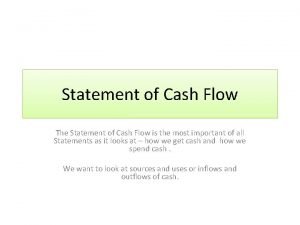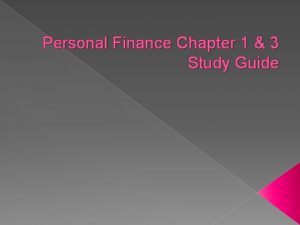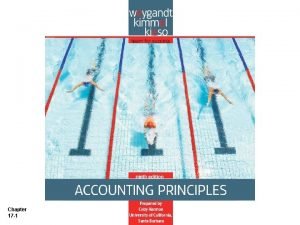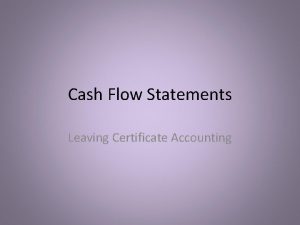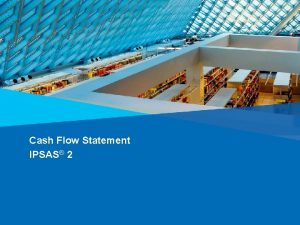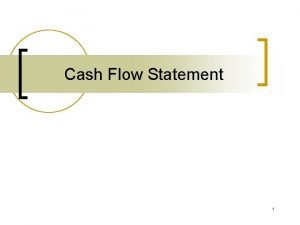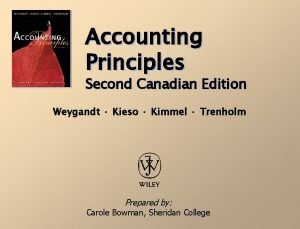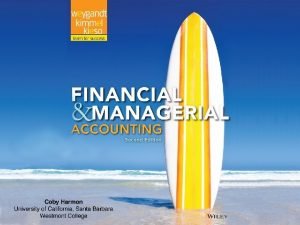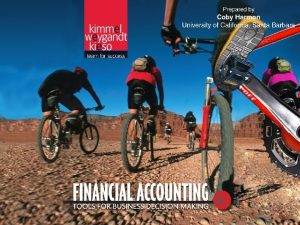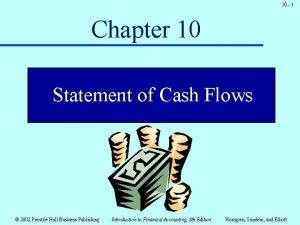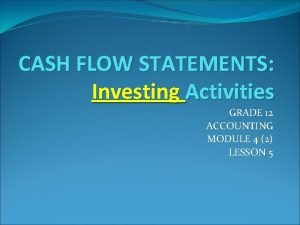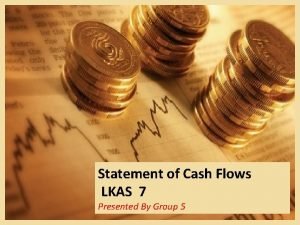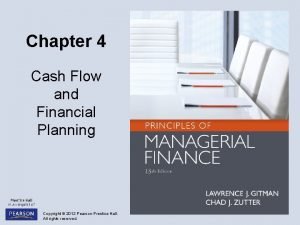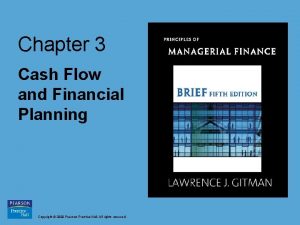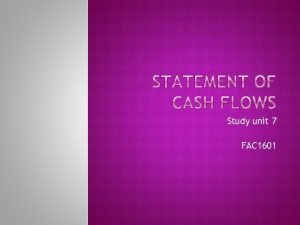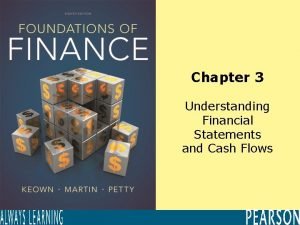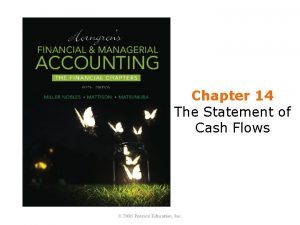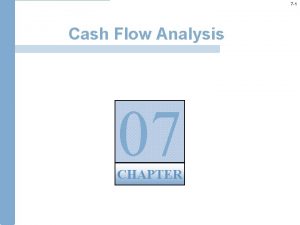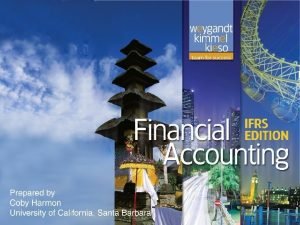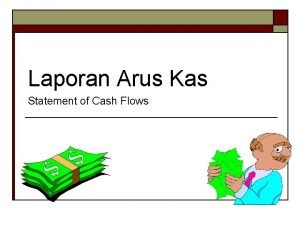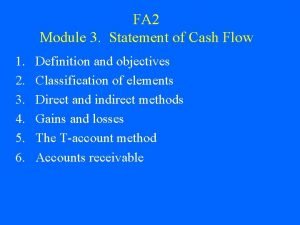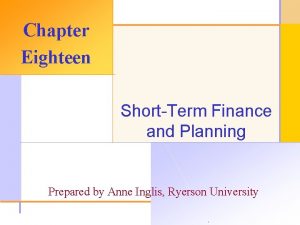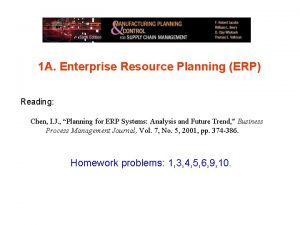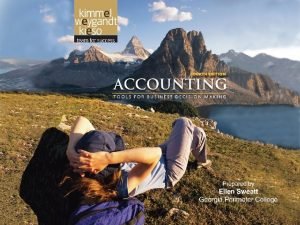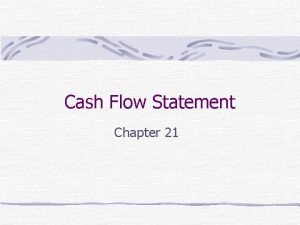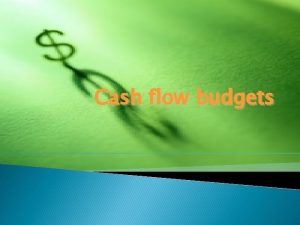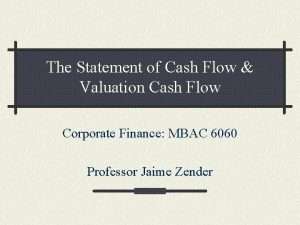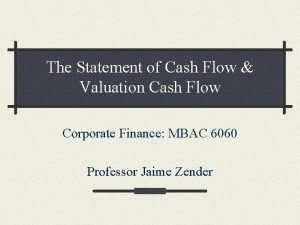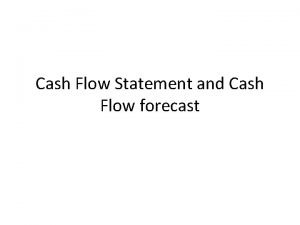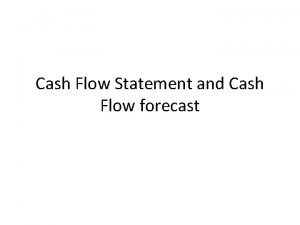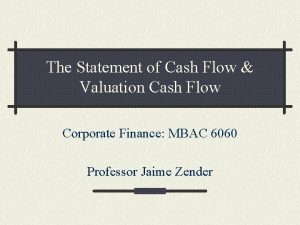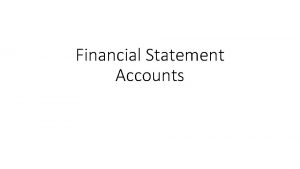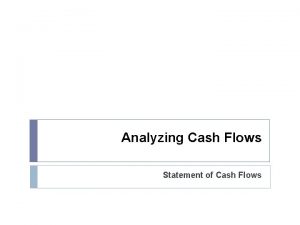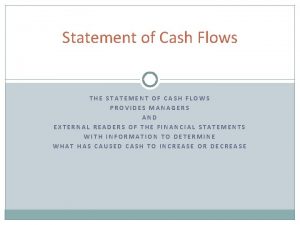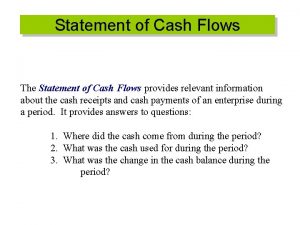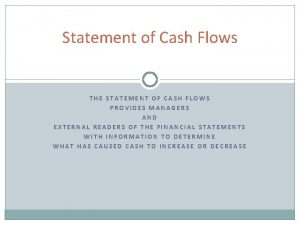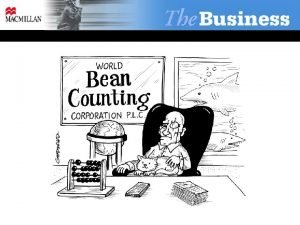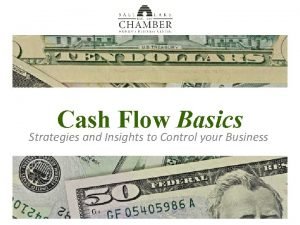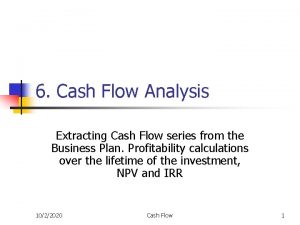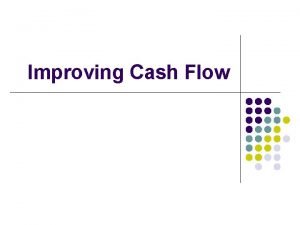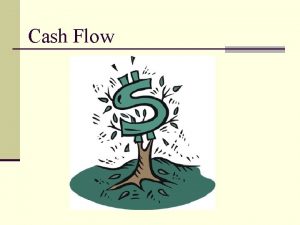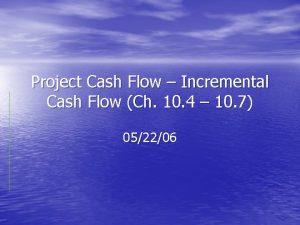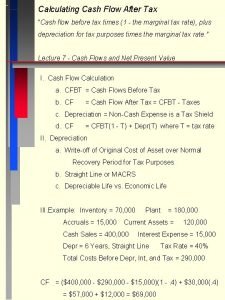FA 2 Module 3 Statement of Cash Flow
























- Slides: 24

FA 2 Module 3. Statement of Cash Flow 1. 2. 3. 4. 5. 6. Definition and objectives Classification of elements Direct and indirect methods Gains and losses The T-account method Accounts receivable

1. SCF: Definition and objectives The Statement of Cash Flow (formerly Statement of Changes in Financial Position) shows the changes in Cash and Cash Equivalents arising from the operating, financing and investing activities of the enterprise. This information is useful for: 1. understanding effects of operating, financing and investing activities on cash; 2. assessing liquidity and solvency; and 3. assessing the firm=s ability to generate cash from internal sources.

Cash and cash equivalents include cash, plus temporary investments that are highly liquid (e. g. , maturities of three months or less, like treasury bills). Investments in equities are excluded (no maturity date). Bank overdraft can be considered “negative” cash equivalent if bank balance fluctuates regularly between positive and negative.

2. Classification of elements a. Operating activities Definition Cash flows related to central revenuegenerating activities Inflow Cash collected from customers Examples Outflow Cash paid to suppliers, salaries, etc. , examples paid

2. Classification of elements b. Investing activities Definition Cash flows related to acquisition or disposal of long-term assets and non-cash investments Inflow Cash from sale of non-cash. Examples equivalent investments and longterm assets Outflow Cash paid for non-cash-equivalent examples investments, fixed assets

2. Classification of elements c. Financing activities Definition Cash flows related to debt and shareholders’ equity Inflow Examples Cash from issue of debt and shares Outflow examples Redemption of shares, repayment of debt

2. Classification of elements - Choices Interest paid Operating or Financing Dividends paid Operating or Financing Interest received Operating or Investing Dividends received Income taxes paid Operating or Investing Operating, but should be in investing or financing if clearly associated with investing or financing transaction

Format of the SCF Operating activities Net cash flows from operations Investing activities Acquisitions of non-current assets ($) Dispositions of non-current assets $ Net cash from (used by) investing activities Financing activities Issues of shares/debt $ Redemption of shares/debt repayment ($) Net cash from (used by) financing activities Net change in cash and cash equivalents $ $

3. SCF: Direct and indirect methods There are two methods of presentation of the SCF: the direct and indirect methods. The only difference is in the presentation of cash from operating activities. Direct method (preferred by IFRS) Cash inflows from operations $ Cash outflows related to operations $ Net cash from operations $ Indirect method Net income $ +/- diff. between accrual and cash acctg $ Net cash from operations $

Direct method Cash flows from operations are identified and grouped by type (e. g. , cash collected from customers, cash paid to suppliers) Cash from = Sales revenue (income stmt) customers +decrease/-increase in AR +inc. /-dec. in customer advances Cash paid = Expense item (income stmt) for an +inc. /-dec. in associated asset expense +dec. /-inc. in associated liability Example: A 5 -13

Indirect method 1. Starting point is net income. 2. Eliminate revenues and expenses that do not provide or use cash (e. g. , amortization). 3. The resulting figure is adjusted for changes in balance sheet accounts that are associated with operating activities (e. g. , accounts receivable, inventory, accounts payable, etc. ):

Indirect method (two-step presentation) Net income $ - Non-cash revenues ($) + Non-cash expenses $ $ Changes in non-cash working capital - increases in associated assets ($) +decreases in associated assets $ + increases in associated liabilities $ - decreases in associated liabilities ($) Net cash from operations $ Example: A 5 -13

4. Gains and losses arise from incidental and/or peripheral transactions that tend to be investing (e. g. , sale of fixed asset) or financing (e. g. , retirement of debt) activities. The gain or loss is generally the difference between any net cash flow related to the transaction and the book value of the asset or liability in question. The cash flow should be in the statement of cash flow; the gain or loss should not.

Gains, losses and the cash flow statement Direct method Gains and losses are generally not included in operating activities; the related cash flow is presented in the appropriate SCF section. Indirect method Gains are deducted from, and losses added back to, net income in the operating activities section. The related cash flow is presented in the appropriate SCF section.

Gain example: Hogan Ltd Sales for the year were $70. Operating expenses for the year were $40. Aside from depreciation ($5), there were no non-cash sales or expenses. During the year, Hogan sold a piece of equipment (cost = $22; accumulated depreciation = $7) for $25. There were no other investing or financing activities during the year. The tax rate is 20% and all taxes were paid during the year. Required: Prepare the income statement. Prepare the cash flow statement using (1) the direct method; and (2) the indirect method.

5. The T-account method is a quick, informal way to organize information to prepare a cash flow statement. It works best for indirect method SCF. The steps are: 1. Prepare t-accounts for each balance sheet account with the beginning and ending balance. There are 3 cash and cashequivalent accounts, one for each of the cash flow statement sections.

5. The T-account method 2. Go through the income statement and additional information and “post” the implied transactions to the t-accounts. Non -cash income statement items are posted to Cash from operating activities. 3. Go through each of the balance sheet accounts and identify any unexplained variations. Using the most obvious explanation, assume and “post” the transaction.

5. The T-account method 4. Using the numbers in the three cash accounts, assemble the cash flow statement. Often-used shortcut: Do not bother with taccounts for the working capital accounts – usually, only the changes in these accounts matter. The non-working capital accounts are frequently affected by more than one cash transaction. Example: A 5 -22

6. Accounts receivable The usual cash flow statement treatment accorded accounts receivable and cash collections from customers is to add (subtract) the decrease (increase) in accounts receivable. The situation is usually more complicated than that because: – Bad debt expense is a non-cash expense – Some accounts receivable are never collected (write-offs)

Accounts receivable transactions Dr. Accounts receivable Sales Cr. Revenue Dr. Cash Collections Cr. Accounts receivable Dr. Bad debt expense Est. bad debts Cr. Allowance for doubtful accounts Dr. Allowance for doubtful accounts write-offs Cr. Accounts receivable

Gross accounts receivable method Accounts receivable Beginning balance (Credit) Sales Write-offs Collections Ending balance Collections = Sales – write-offs + decrease in AR – increase in AR

SCF example: Gould Inc. 2011 2010 Accounts receivable $70 $60 Allowance for doubtful accountants (8) (5) Accounts receivable (net) 62 55 Revenue $200 Bad debt expense 12 Other expenses (all paid in cash) 40 Net income $148 In 2011, $9 in accounts receivable were written off as uncollectible. Prepare the operating activities section of the SCF.

Net accounts receivable method Net accounts receivable (AR + AFDA) Beg. Bal. (AR-AFDA) Bad debt expense (Credit) Sales Collections Write-offs Ending balance Collections = Sales – bad debt expense + decrease in net AR – increase in net AR

Net cash from operating activities (Credit sales, cash expenses except bad debt) Direct method AR (gross) AR (net) Collections (sales – write-offs +/- chg in gross AR) - Expenses paid Indirect method Net income + Bad debt expense - Write-offs +/- chg in gross AR Collections (sales – Net income bad debt expense – +/- chg in net AR) - Expenses paid
 Salaries paid in cash flow statement
Salaries paid in cash flow statement A savings option many employers offer is
A savings option many employers offer is Prepaid expenses statement of cash flows
Prepaid expenses statement of cash flows Accounting leaving cert notes
Accounting leaving cert notes Ipsas 2
Ipsas 2 Increase in debtors in cash flow statement
Increase in debtors in cash flow statement Cash flow statement indirect method
Cash flow statement indirect method Net cash flow from investing activities
Net cash flow from investing activities What are plant assets
What are plant assets Cash flow statement
Cash flow statement Cash flow statement format grade 12
Cash flow statement format grade 12 Lkas 07
Lkas 07 Baker corporation cash flow statement
Baker corporation cash flow statement Baker corporation cash flow statement
Baker corporation cash flow statement Fac1601 cash flow statement
Fac1601 cash flow statement How to calculate cash flow from profit and loss statement
How to calculate cash flow from profit and loss statement Statement of cash flow direct method
Statement of cash flow direct method Cash flow statement
Cash flow statement Juarez company acquired $1 200
Juarez company acquired $1 200 Statement of cash flow direct method
Statement of cash flow direct method Cash flow 1 2 3
Cash flow 1 2 3 Cash to cash cycle time
Cash to cash cycle time Cash to cash cycle time
Cash to cash cycle time Cash-in cash-out
Cash-in cash-out The cash budget shows anticipated cash flows
The cash budget shows anticipated cash flows
